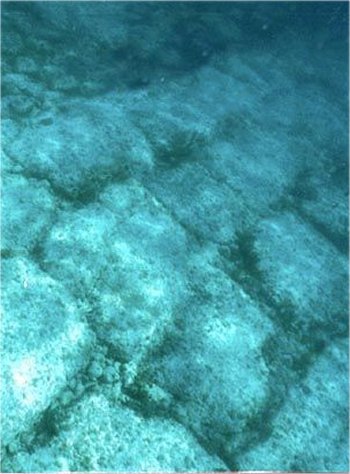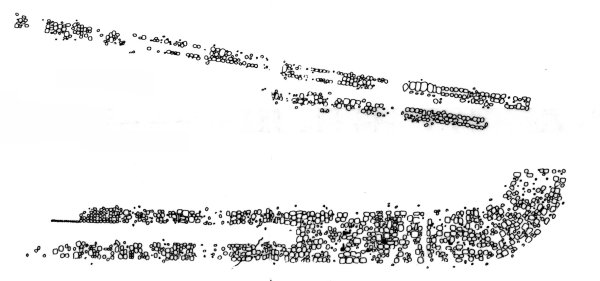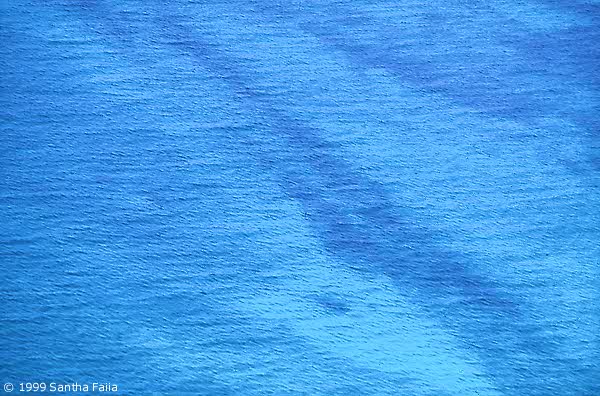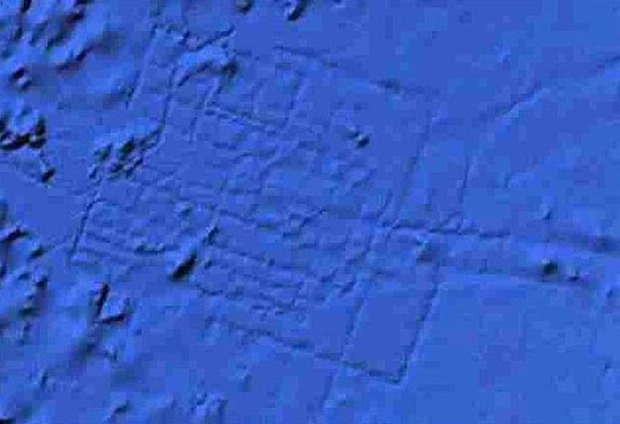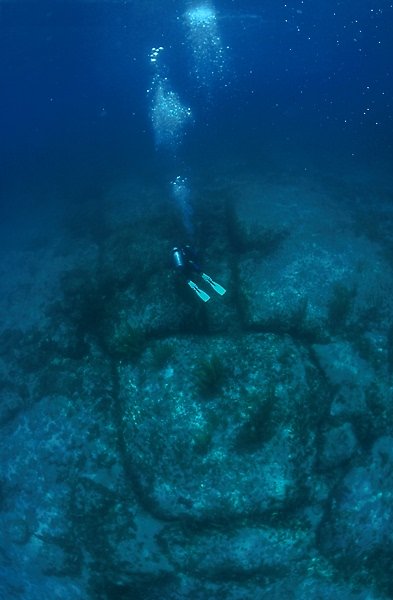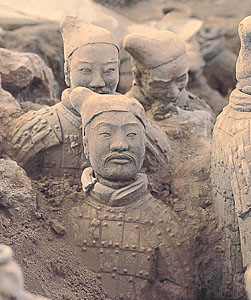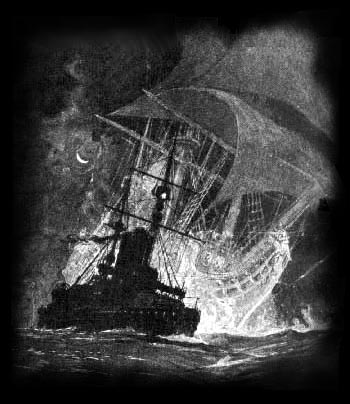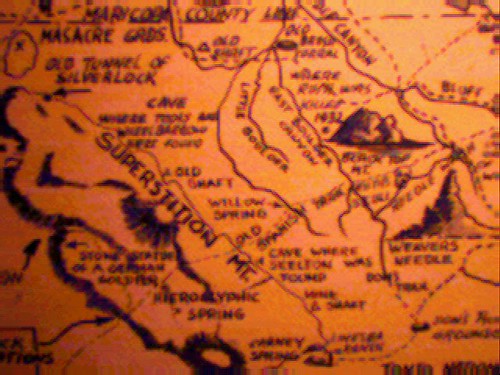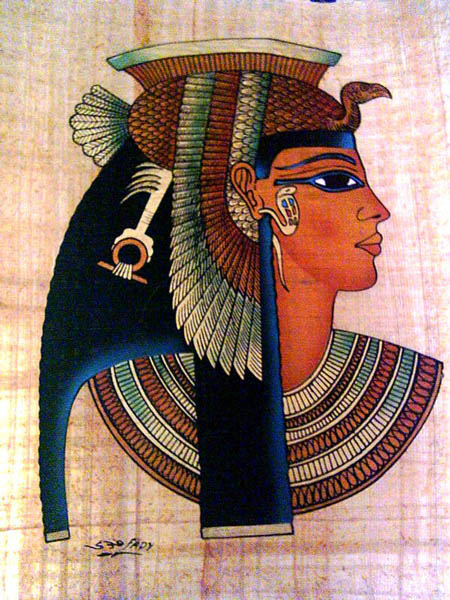In the middle of a terrifying desert north of Tibet, Chinese archaeologists have excavated an extraordinary cemetery. Its inhabitants died almost 4,000 years ago, yet their bodies have been well preserved by the dry air.
 The cemetery lies in what is now China’s northwest autonomous region of Xinjiang, yet the people have European features, with brown hair and long noses. Their remains, though lying in one of the world’s largest deserts, are buried in upside-down boats. And where tombstones might stand, declaring pious hope for some god’s mercy in the afterlife, their cemetery sports instead a vigorous forest of phallic symbols, signaling an intense interest in the pleasures or utility of procreation.
The cemetery lies in what is now China’s northwest autonomous region of Xinjiang, yet the people have European features, with brown hair and long noses. Their remains, though lying in one of the world’s largest deserts, are buried in upside-down boats. And where tombstones might stand, declaring pious hope for some god’s mercy in the afterlife, their cemetery sports instead a vigorous forest of phallic symbols, signaling an intense interest in the pleasures or utility of procreation.
The long-vanished people have no name, because their origin and identity are still unknown. But many clues are now emerging about their ancestry, their way of life and even the language they spoke.
 Their graveyard, known as Small River Cemetery No. 5, lies near a dried-up riverbed in the Tarim Basin, a region encircled by forbidding mountain ranges. Most of the basin is occupied by the Taklimakan Desert, a wilderness so inhospitable that later travelers along the Silk Road would edge along its northern or southern borders.
Their graveyard, known as Small River Cemetery No. 5, lies near a dried-up riverbed in the Tarim Basin, a region encircled by forbidding mountain ranges. Most of the basin is occupied by the Taklimakan Desert, a wilderness so inhospitable that later travelers along the Silk Road would edge along its northern or southern borders.
In modern times the region has been occupied by Turkish-speaking Uighurs, joined in the last 50 years by Han settlers from China. Ethnic tensions have recently arisen between the two groups, with riots in Urumqi, the capital of Xinjiang. A large number of ancient mummies, really desiccated corpses, have emerged from the sands, only to become pawns between the Uighurs and the Han.
The 200 or so mummies have a distinctively Western appearance, and the Uighurs, even though they did not arrive in the region until the 10th century, have cited them to claim that the autonomous region was always theirs. Some of the mummies, including a well-preserved woman known as the Beauty of Loulan, were analyzed by Li Jin, a well-known geneticist at Fudan University, who said in 2007 that their DNA contained markers indicating an East Asian and even South Asian origin.
The mummies in the Small River Cemetery are, so far, the oldest discovered in the Tarim Basin. Carbon tests done at Beijing University show that the oldest part dates to 3,980 years ago. A team of Chinese geneticists has analyzed the mummies’ DNA.
 Despite the political tensions over the mummies’ origin, the Chinese said in a report published last month in the journal BMC Biology that the people were of mixed ancestry, having both European and some Siberian genetic markers, and probably came from outside China. The team was led by Hui Zhou of Jilin University in Changchun, with Dr. Jin as a co-author.
Despite the political tensions over the mummies’ origin, the Chinese said in a report published last month in the journal BMC Biology that the people were of mixed ancestry, having both European and some Siberian genetic markers, and probably came from outside China. The team was led by Hui Zhou of Jilin University in Changchun, with Dr. Jin as a co-author.
All the men who were analyzed had a Y chromosome that is now mostly found in Eastern Europe, Central Asia and Siberia, but rarely in China. The mitochondrial DNA, which passes down the female line, consisted of a lineage from Siberia and two that are common in Europe. Since both the Y chromosome and the mitochondrial DNA lineages are ancient, Dr. Zhou and his team conclude the European and Siberian populations probably intermarried before entering the Tarim Basin some 4,000 years ago.
The Small River Cemetery was rediscovered in 1934 by the Swedish archaeologist Folke Bergman and then forgotten for 66 years until relocated through GPS navigation by a Chinese expedition. Archaeologists began excavating it from 2003 to 2005. Their reports have been translated and summarized by Victor H. Mair, a professor of Chinese at the University of Pennsylvania and an expert in the prehistory of the Tarim Basin.
 As the Chinese archaeologists dug through the five layers of burials, Dr. Mair recounted, they came across almost 200 poles, each 13 feet tall. Many had flat blades, painted black and red, like the oars from some great galley that had foundered beneath the waves of sand.
As the Chinese archaeologists dug through the five layers of burials, Dr. Mair recounted, they came across almost 200 poles, each 13 feet tall. Many had flat blades, painted black and red, like the oars from some great galley that had foundered beneath the waves of sand.
At the foot of each pole there were indeed boats, laid upside down and covered with cowhide. The bodies inside the boats were still wearing the clothes they had been buried in. They had felt caps with feathers tucked in the brim, uncannily resembling Tyrolean mountain hats. They wore large woolen capes with tassels and leather boots. A Bronze Age salesclerk from Victoria’s Secret seems to have supplied the clothes beneath — barely adequate woolen loin cloths for the men, and skirts made of string strands for the women.
Within each boat coffin were grave goods, including beautifully woven grass baskets, skillfully carved masks and bundles of ephedra, an herb that may have been used in rituals or as a medicine.
In the women’s coffins, the Chinese archaeologists encountered one or more life-size wooden phalluses laid on the body or by its side. Looking again at the shaping of the 13-foot poles that rise from the prow of each woman’s boat, the archaeologists concluded that the poles were in fact gigantic phallic symbols.
The men’s boats, on the other hand, all lay beneath the poles with bladelike tops. These were not the oars they had seemed at first sight, the Chinese archaeologists concluded, but rather symbolic vulvas that matched the opposite sex symbols above the women’s boats. “The whole of the cemetery was blanketed with blatant sexual symbolism,” Dr. Mair wrote. In his view, the “obsession with procreation” reflected the importance the community attached to fertility.
Arthur Wolf, an anthropologist at Stanford University and an expert on fertility in East Asia, said that the poles perhaps mark social status, a common theme of tombs and grave goods. “It seems that what most people want to take with them is their status, if it is anything to brag about,” he said.
Dr. Mair said the Chinese archaeologists’ interpretation of the poles as phallic symbols was “a believable analysis.” The buried people’s evident veneration of procreation could mean they were interested in both the pleasure of sex and its utility, given that it is difficult to separate the two. But they seem to have had particular respect for fertility, Dr. Mair said, because several women were buried in double-layered coffins with special grave goods.
Living in harsh surroundings, “infant mortality must have been high, so the need for procreation, particularly in light of their isolated situation, would have been great,” Dr. Mair said. Another possible risk to fertility could have arisen if the population had become in-bred. “Those women who were able to produce and rear children to adulthood would have been particularly revered,” Dr. Mair said.
Several items in the Small River Cemetery burials resemble artifacts or customs familiar in Europe, Dr. Mair noted. Boat burials were common among the Vikings. String skirts and phallic symbols have been found in Bronze Age burials of Northern Europe.
There are no known settlements near the cemetery, so the people probably lived elsewhere and reached the cemetery by boat. No woodworking tools have been found at the site, supporting the idea that the poles were carved off site.
 The Tarim Basin was already quite dry when the Small River people entered it 4,000 years ago. They probably lived at the edge of survival until the lakes and rivers on which they depended finally dried up around A.D. 400. Burials with felt hats and woven baskets were common in the region until some 2,000 years ago.
The Tarim Basin was already quite dry when the Small River people entered it 4,000 years ago. They probably lived at the edge of survival until the lakes and rivers on which they depended finally dried up around A.D. 400. Burials with felt hats and woven baskets were common in the region until some 2,000 years ago.
The language spoken by the people of the Small River Cemetery is unknown, but Dr. Mair believes it could have been Tokharian, an ancient member of the Indo-European family of languages. Manuscripts written in Tokharian have been discovered in the Tarim Basin, where the language was spoken from about A.D. 500 to 900. Despite its presence in the east, Tokharian seems more closely related to the “centum” languages of Europe than to the “satem” languages of India and Iran. The division is based on the words for hundred in Latin (centum) and in Sanskrit (satam).
The Small River Cemetery people lived more than 2,000 years before the earliest evidence for Tokharian, but there is “a clear continuity of culture,” Dr. Mair said, in the form of people being buried with felt hats, a tradition that continued until the first few centuries A.D.
An exhibition of the Tarim Basin mummies opens March 27 at the Bowers Museum in Santa Ana, Calif. — the first time that the mummies will be seen outside Asia.
 The cemetery lies in what is now China’s northwest autonomous region of Xinjiang, yet the people have European features, with brown hair and long noses. Their remains, though lying in one of the world’s largest deserts, are buried in upside-down boats. And where tombstones might stand, declaring pious hope for some god’s mercy in the afterlife, their cemetery sports instead a vigorous forest of phallic symbols, signaling an intense interest in the pleasures or utility of procreation.
The cemetery lies in what is now China’s northwest autonomous region of Xinjiang, yet the people have European features, with brown hair and long noses. Their remains, though lying in one of the world’s largest deserts, are buried in upside-down boats. And where tombstones might stand, declaring pious hope for some god’s mercy in the afterlife, their cemetery sports instead a vigorous forest of phallic symbols, signaling an intense interest in the pleasures or utility of procreation.The long-vanished people have no name, because their origin and identity are still unknown. But many clues are now emerging about their ancestry, their way of life and even the language they spoke.
 Their graveyard, known as Small River Cemetery No. 5, lies near a dried-up riverbed in the Tarim Basin, a region encircled by forbidding mountain ranges. Most of the basin is occupied by the Taklimakan Desert, a wilderness so inhospitable that later travelers along the Silk Road would edge along its northern or southern borders.
Their graveyard, known as Small River Cemetery No. 5, lies near a dried-up riverbed in the Tarim Basin, a region encircled by forbidding mountain ranges. Most of the basin is occupied by the Taklimakan Desert, a wilderness so inhospitable that later travelers along the Silk Road would edge along its northern or southern borders.In modern times the region has been occupied by Turkish-speaking Uighurs, joined in the last 50 years by Han settlers from China. Ethnic tensions have recently arisen between the two groups, with riots in Urumqi, the capital of Xinjiang. A large number of ancient mummies, really desiccated corpses, have emerged from the sands, only to become pawns between the Uighurs and the Han.
The 200 or so mummies have a distinctively Western appearance, and the Uighurs, even though they did not arrive in the region until the 10th century, have cited them to claim that the autonomous region was always theirs. Some of the mummies, including a well-preserved woman known as the Beauty of Loulan, were analyzed by Li Jin, a well-known geneticist at Fudan University, who said in 2007 that their DNA contained markers indicating an East Asian and even South Asian origin.
The mummies in the Small River Cemetery are, so far, the oldest discovered in the Tarim Basin. Carbon tests done at Beijing University show that the oldest part dates to 3,980 years ago. A team of Chinese geneticists has analyzed the mummies’ DNA.
 Despite the political tensions over the mummies’ origin, the Chinese said in a report published last month in the journal BMC Biology that the people were of mixed ancestry, having both European and some Siberian genetic markers, and probably came from outside China. The team was led by Hui Zhou of Jilin University in Changchun, with Dr. Jin as a co-author.
Despite the political tensions over the mummies’ origin, the Chinese said in a report published last month in the journal BMC Biology that the people were of mixed ancestry, having both European and some Siberian genetic markers, and probably came from outside China. The team was led by Hui Zhou of Jilin University in Changchun, with Dr. Jin as a co-author.All the men who were analyzed had a Y chromosome that is now mostly found in Eastern Europe, Central Asia and Siberia, but rarely in China. The mitochondrial DNA, which passes down the female line, consisted of a lineage from Siberia and two that are common in Europe. Since both the Y chromosome and the mitochondrial DNA lineages are ancient, Dr. Zhou and his team conclude the European and Siberian populations probably intermarried before entering the Tarim Basin some 4,000 years ago.
The Small River Cemetery was rediscovered in 1934 by the Swedish archaeologist Folke Bergman and then forgotten for 66 years until relocated through GPS navigation by a Chinese expedition. Archaeologists began excavating it from 2003 to 2005. Their reports have been translated and summarized by Victor H. Mair, a professor of Chinese at the University of Pennsylvania and an expert in the prehistory of the Tarim Basin.
 As the Chinese archaeologists dug through the five layers of burials, Dr. Mair recounted, they came across almost 200 poles, each 13 feet tall. Many had flat blades, painted black and red, like the oars from some great galley that had foundered beneath the waves of sand.
As the Chinese archaeologists dug through the five layers of burials, Dr. Mair recounted, they came across almost 200 poles, each 13 feet tall. Many had flat blades, painted black and red, like the oars from some great galley that had foundered beneath the waves of sand.At the foot of each pole there were indeed boats, laid upside down and covered with cowhide. The bodies inside the boats were still wearing the clothes they had been buried in. They had felt caps with feathers tucked in the brim, uncannily resembling Tyrolean mountain hats. They wore large woolen capes with tassels and leather boots. A Bronze Age salesclerk from Victoria’s Secret seems to have supplied the clothes beneath — barely adequate woolen loin cloths for the men, and skirts made of string strands for the women.
Within each boat coffin were grave goods, including beautifully woven grass baskets, skillfully carved masks and bundles of ephedra, an herb that may have been used in rituals or as a medicine.
In the women’s coffins, the Chinese archaeologists encountered one or more life-size wooden phalluses laid on the body or by its side. Looking again at the shaping of the 13-foot poles that rise from the prow of each woman’s boat, the archaeologists concluded that the poles were in fact gigantic phallic symbols.
The men’s boats, on the other hand, all lay beneath the poles with bladelike tops. These were not the oars they had seemed at first sight, the Chinese archaeologists concluded, but rather symbolic vulvas that matched the opposite sex symbols above the women’s boats. “The whole of the cemetery was blanketed with blatant sexual symbolism,” Dr. Mair wrote. In his view, the “obsession with procreation” reflected the importance the community attached to fertility.
Arthur Wolf, an anthropologist at Stanford University and an expert on fertility in East Asia, said that the poles perhaps mark social status, a common theme of tombs and grave goods. “It seems that what most people want to take with them is their status, if it is anything to brag about,” he said.
Dr. Mair said the Chinese archaeologists’ interpretation of the poles as phallic symbols was “a believable analysis.” The buried people’s evident veneration of procreation could mean they were interested in both the pleasure of sex and its utility, given that it is difficult to separate the two. But they seem to have had particular respect for fertility, Dr. Mair said, because several women were buried in double-layered coffins with special grave goods.
Living in harsh surroundings, “infant mortality must have been high, so the need for procreation, particularly in light of their isolated situation, would have been great,” Dr. Mair said. Another possible risk to fertility could have arisen if the population had become in-bred. “Those women who were able to produce and rear children to adulthood would have been particularly revered,” Dr. Mair said.
Several items in the Small River Cemetery burials resemble artifacts or customs familiar in Europe, Dr. Mair noted. Boat burials were common among the Vikings. String skirts and phallic symbols have been found in Bronze Age burials of Northern Europe.
There are no known settlements near the cemetery, so the people probably lived elsewhere and reached the cemetery by boat. No woodworking tools have been found at the site, supporting the idea that the poles were carved off site.
 The Tarim Basin was already quite dry when the Small River people entered it 4,000 years ago. They probably lived at the edge of survival until the lakes and rivers on which they depended finally dried up around A.D. 400. Burials with felt hats and woven baskets were common in the region until some 2,000 years ago.
The Tarim Basin was already quite dry when the Small River people entered it 4,000 years ago. They probably lived at the edge of survival until the lakes and rivers on which they depended finally dried up around A.D. 400. Burials with felt hats and woven baskets were common in the region until some 2,000 years ago.The language spoken by the people of the Small River Cemetery is unknown, but Dr. Mair believes it could have been Tokharian, an ancient member of the Indo-European family of languages. Manuscripts written in Tokharian have been discovered in the Tarim Basin, where the language was spoken from about A.D. 500 to 900. Despite its presence in the east, Tokharian seems more closely related to the “centum” languages of Europe than to the “satem” languages of India and Iran. The division is based on the words for hundred in Latin (centum) and in Sanskrit (satam).
The Small River Cemetery people lived more than 2,000 years before the earliest evidence for Tokharian, but there is “a clear continuity of culture,” Dr. Mair said, in the form of people being buried with felt hats, a tradition that continued until the first few centuries A.D.
An exhibition of the Tarim Basin mummies opens March 27 at the Bowers Museum in Santa Ana, Calif. — the first time that the mummies will be seen outside Asia.




















